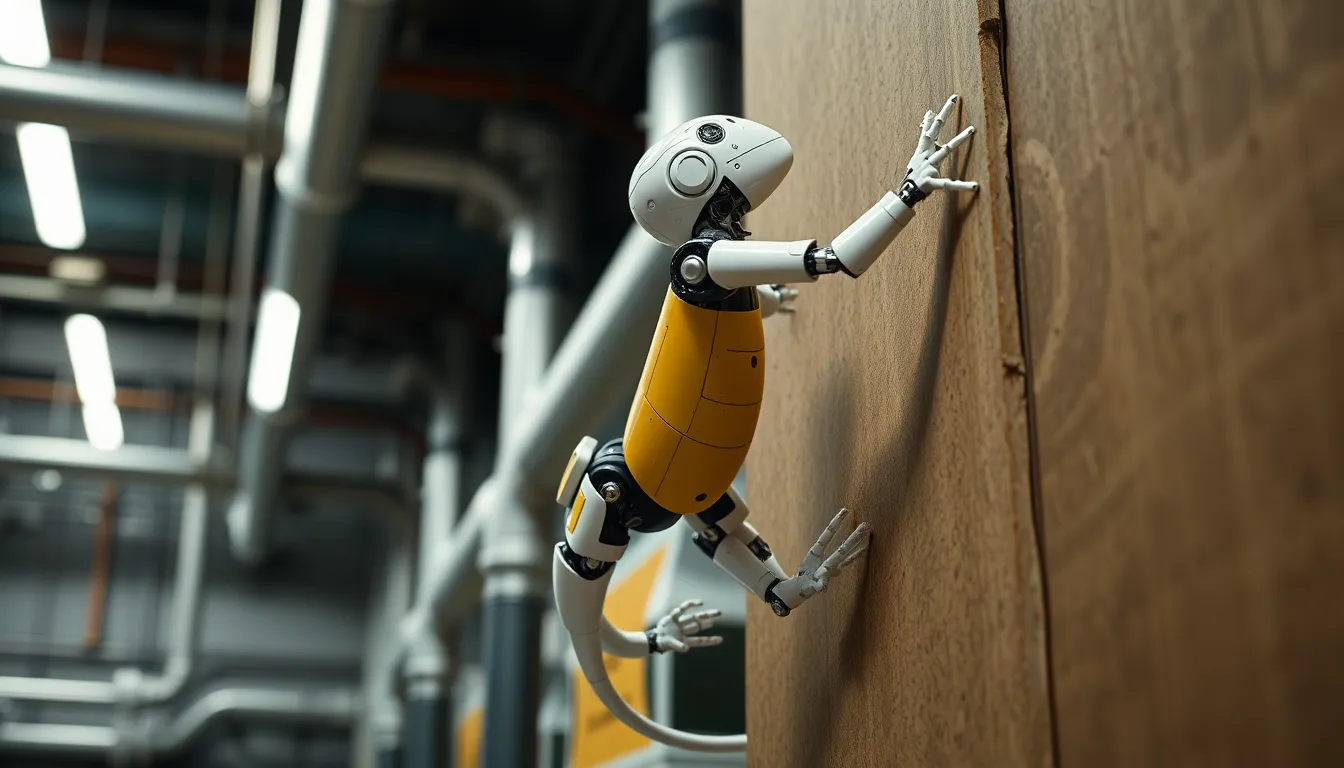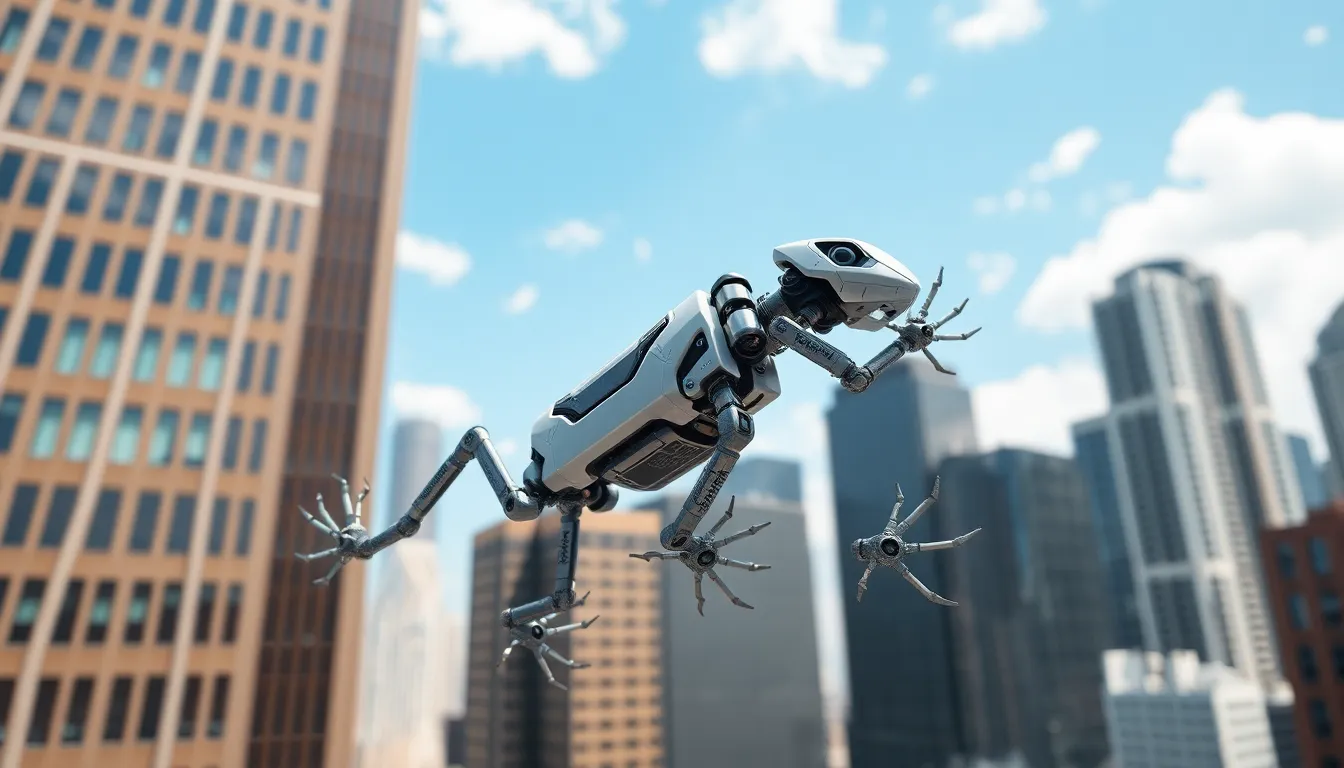Imagine a world where robots cling to walls and scurry across ceilings like tiny superheroes. Enter gecko robotics, inspired by the remarkable adhesive abilities of geckos themselves. These innovative machines are transforming industries, from construction to inspection, by navigating hard-to-reach places with ease.
With their unique design, gecko robots promise to take on tasks that would make even the bravest human cringe. Whether it’s scaling skyscrapers or checking out those pesky roof leaks, these robots are ready to tackle challenges head-on. As technology advances, gecko robotics is paving the way for a future where efficiency and safety go hand in hand, leaving humans free to focus on more important things—like binge-watching their favorite shows.
Table of Contents
ToggleOverview of Gecko Robotics
Gecko robotics harnesses the unique adhesive properties of geckos to tackle various industrial challenges. These robots excel in navigating hard-to-reach locations, making them invaluable in sectors like construction and inspection. Their design mimics the gecko’s ability to climb surfaces, enabling them to scale structures such as skyscrapers and inspect components like roof leaks.
Adoption of gecko robotics contributes to increased efficiency and heightened safety across operational environments. These robots conduct inspections with precision, significantly reducing the risk associated with human workers in hazardous positions. By incorporating advanced technologies, companies can automate routine tasks, which allows human resources to focus on more complex responsibilities.
Gecko robotics functions in diverse settings, including bridges, wind turbines, and oil rigs. Each application showcases the versatility of these robots, highlighting their ability to adapt to various materials and structures. Maintenance teams benefit from real-time data collected by these robotic systems, enhancing decision-making processes.
Inspection procedures transform with the deployment of gecko robots. Conventional methods often involve scaffolding or cranes, presenting risks and increasing timelines. Automation, powered by these innovations, not only mitigates danger but also accelerates project completion.
Emerging applications promise to expand the role of gecko robotics in additional industries. Enhanced durability and functionality will likely elevate these tools further in fields such as aerospace and manufacturing. As technology advances, the potential for increased utility strengthens, indicating a bright future for gecko robotics in streamlining operations and enhancing safety standards.
Technology Behind Gecko Robotics

Gecko robotics utilize advanced technologies inspired by nature to achieve impressive functionality. Two crucial areas of focus involve adhesive mechanisms and navigation control.
Adhesive Mechanisms
Adhesive mechanisms mimic the natural abilities of geckos, allowing robots to adhere to various surfaces. These robots employ a special material that replicates the microscopic setae found on a gecko’s feet. The unique design generates van der Waals forces, enabling the robots to stick securely to walls, ceilings, and other vertical surfaces. This adhesion capacity ensures they perform tasks in difficult-to-reach locations, significantly enhancing operational versatility. Applications of this technology span multiple industries, proving essential for maintenance, inspection, and construction scenarios.
Navigation and Control
An effective navigation and control system makes gecko robotics agile and precise. Built-in sensors facilitate real-time data collection about surroundings, enabling robots to adjust their movements accordingly. Advanced algorithms allow for dynamic route planning, ensuring effective operation in complex environments. Operators can remotely control the robots or set autonomous functions, optimizing efficiency and reducing human error. The navigation capabilities make gecko robotics ideal for challenging inspections, where reliability and adaptability are paramount.
Applications of Gecko Robotics
Gecko robotics find diverse applications across multiple industries, showcasing their versatility and effectiveness in enhancing operational efficiency.
Industrial Inspections
Industrial inspections benefit significantly from gecko robotics. These robots can navigate complex machinery and equipment, reaching areas typically difficult for human inspectors. They streamline processes by providing real-time data and detailed visuals. Robots equipped with advanced sensors detect anomalies that may indicate potential failures. Organizations relying on precise data enhance their decision-making processes while reducing downtime and maintenance costs.
Infrastructure Maintenance
Infrastructure maintenance sees remarkable improvements through the use of gecko robotics. These robots can easily climb vertical surfaces and traverse hard-to-reach locations, enabling thorough inspections of bridges, wind turbines, and oil rigs. Additionally, they identify structural weaknesses before they escalate into severe issues. Their capabilities allow teams to allocate resources more efficiently, ensuring timely repairs and reducing the risk of accidents. By using gecko robotics, companies enhance safety and prolong the lifespan of critical infrastructure.
Benefits of Using Gecko Robotics
Gecko robotics offer numerous advantages across various industries. Their efficiency and safety features significantly enhance operational capabilities.
Efficiency and Cost-Effectiveness
Gecko robotics enhance efficiency in inspection procedures, allowing companies to minimize labor costs and reduce project timelines. Reduced reliance on scaffolding or cranes lowers operational expenses, making these robots a cost-effective alternative. Faster inspections mean minimal disruption to ongoing work, ensuring that projects progress smoothly. Additionally, organizations save on maintenance costs due to proactive monitoring of infrastructure. Equipped with real-time data collection capabilities, these robots deliver crucial insights that streamline decision-making processes.
Safety Enhancements
Safety standards improve with the implementation of gecko robotics, as they perform inspections in hazardous environments without exposing human workers to risks. Inspections conducted by these robots minimize the need for personnel in precarious positions, reducing the likelihood of accidents. Advanced navigation and sensor technologies ensure precise movements, preventing potential damage to structures and equipment. In high-risk areas, gecko robotics can identify weaknesses before they escalate into severe issues, allowing timely interventions that enhance overall safety. This proactive approach ultimately fosters safer working environments across multiple sectors.
Future Prospects of Gecko Robotics
Gecko robotics are set to transform various sectors with their innovative capabilities. Continued advancements in adhesive technology promise to enhance the robots’ ability to adhere to diverse surfaces. Enhanced sensors are likely to improve navigation and real-time data collection, allowing for more sophisticated inspections. With a focus on automation, these robots can easily take on routine inspections while human workers handle complex tasks.
Industries beyond construction and inspection are beginning to explore the potential of gecko robotics. Aerospace applications appear promising, where the need for precise inspections of aircraft may reduce downtime significantly. Manufacturing processes can also benefit, as these robots can monitor equipment conditions in real time, preventing costly breakdowns. Investigations into integrating artificial intelligence will deepen the robots’ capabilities, enabling smarter decision-making during operations.
Market demand for improved safety and efficiency remains strong. Regulatory standards across industries are pushing for advanced solutions that mitigate risks associated with human inspections in hazardous environments. Companies that adopt gecko robotics may experience enhanced productivity and lower operational costs.
Future partnerships among technology developers, industries, and research institutions will drive further innovation. Collectively, these efforts can lead to creating a new generation of robots that not only improve inspection efficiency but also enhance workplace safety. As applications continue to expand, the future landscape of gecko robotics appears bright, paving the way for increased reliance on this technology across diverse fields.
Gecko robotics are set to redefine how industries approach inspections and maintenance. Their unique design and advanced technology not only enhance operational efficiency but also prioritize safety in challenging environments. As these robots continue to evolve, their applications will expand across various sectors, promising significant improvements in safety standards and cost-effectiveness.
The future of gecko robotics looks bright with potential innovations in adhesive technology and artificial intelligence. As organizations increasingly recognize the value of these tools, the integration of gecko robotics will likely become a standard practice in ensuring the integrity of critical infrastructure. Embracing this technology will pave the way for safer and more efficient operational practices in the years to come.




